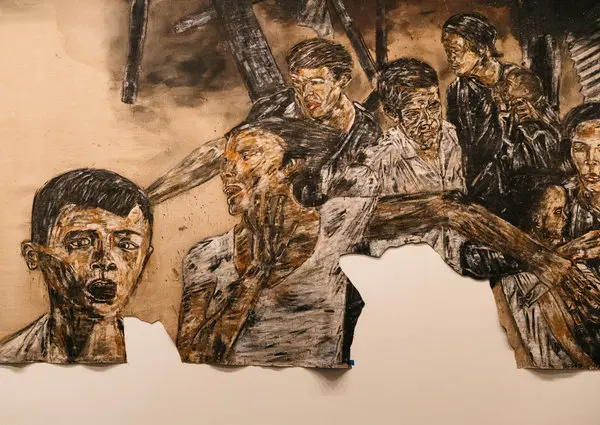By: Jayden Ho
The artist, Tuan Andrew Nguyen, stands resolute in his studio amid an array of his creations – sculpture-like mobiles cut from the chilling metal of unexploded artillery. It’s a unique transformation of war’s grim reminders into pieces of poignant art, and it’s causing an international stir.
Known for his powerful storytelling, Nguyen explores memory and identity, especially regarding the Vietnam War. His art goes beyond physical mediums, incorporating video. Soon, his latest masterpiece titled “The Unburied Sounds of a Troubled Horizon” will take center stage at his inaugural solo museum exhibition in the United States. The exhibition, hosted by the New Museum in Manhattan, is scheduled to open on June 29.
Born in Vietnam in 1976, Nguyen moved with his family to the U.S. when he was just two years old. He grew up in Oklahoma, Texas, and Southern California, where he first discovered his passion for art. Decades later, the artist returned to his homeland to connect with his cultural roots and seek answers to questions about identity and displacement.
His artwork is highly influenced by the lasting impact of the Vietnam War on the country and its people. His latest film “The Unburied Sounds of a Troubled Horizon” explores the lasting trauma and resilience in Quang Tri province, a heavily bombed area during the war that remains riddled with unexploded shells.
Nguyen’s art is not just about representing pain, however. In a beautiful twist of redemption, his work often showcases the potential for healing and transformation, even in the face of profound suffering.
In “The Unburied Sounds of a Troubled Horizon,” the protagonist Nguyet, a scavenger of undetonated artillery, creates large, meticulously balanced mobiles out of bomb casings, drawing inspiration from the style of antiwar sculptor Alexander Calder. In a Buddhist temple, she learns of a temple bell created from the casing of an unexploded American bomb, symbolizing a profound act of transformation and compassion. This actual bell sculpture, along with the Calder-like mobiles, will also feature in the exhibition.
Nguyen’s other works also dive into the effects of colonialism, such as “The Specter of Ancestors Becoming,” which traces the histories of Senegalese soldiers who were forced to fight for the French in Vietnam. These explorations reveal a commitment to unearthing and understanding global interconnected histories, reflecting Nguyen’s own transnational experiences.
His journey from a pre-med student to an internationally recognized artist is an embodiment of his healing ambitions. As he steps back from his work, Nguyen reflects on his aspirations to extend beyond the narratives of Vietnam, saying, “These global moments have brought us to where we are now.”
Nguyen’s work gives voice to the silent, haunted landscapes and the stories buried beneath them. His art proves that memory and trauma, while indelible, can be reimagined, reworked, and transfigured into symbols of hope and healing – even in the face of the harshest realities of war.











